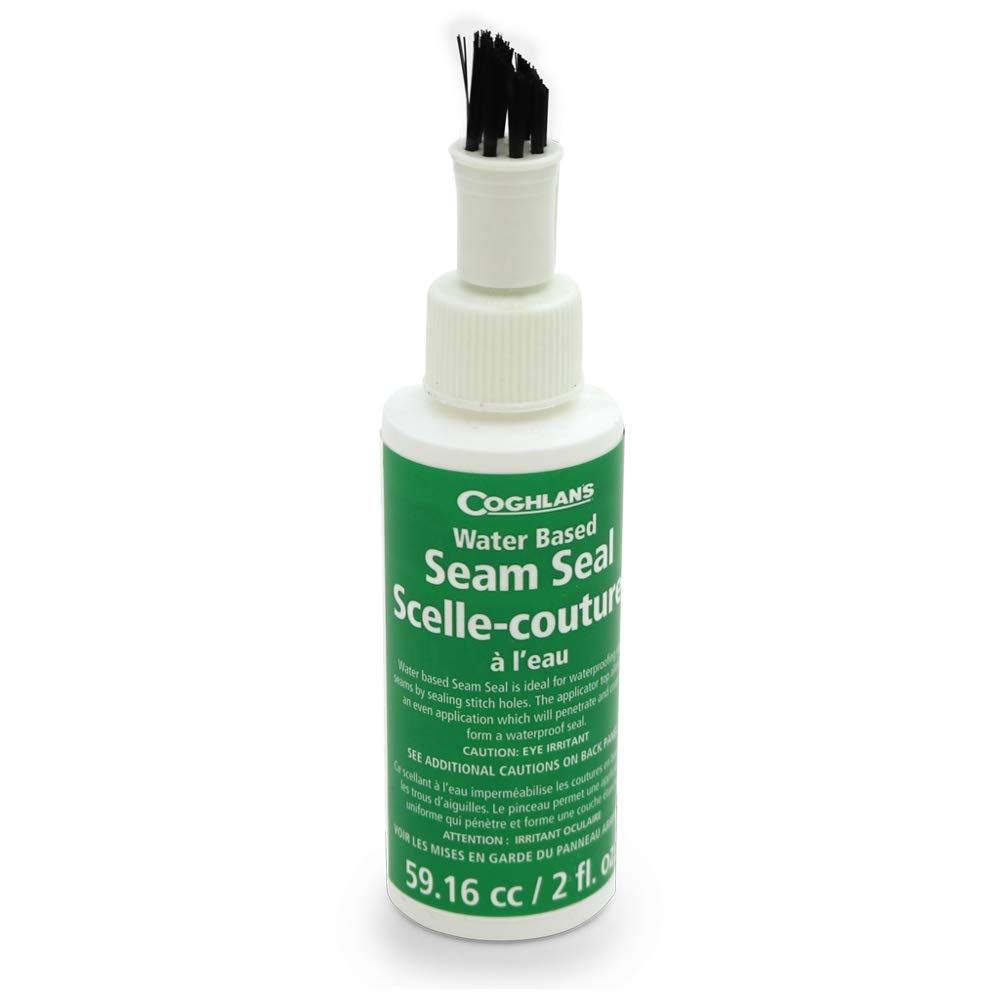Seam sealers are an essential tool for anyone who enjoys hiking and spending time outdoors.
They play a critical role in enhancing the waterproof capabilities of backpacks, tents, and clothing.
As we venture into rugged terrains or face unpredictable weather, having gear that keeps us dry can make a significant difference in our comfort and safety.
When we talk about seam sealers, we’re referring to products specifically designed to fill in the tiny stitches and holes in fabric where water can seep through.
A good seam sealer prevents leaks, ensuring that our gear can withstand rain, sleet, and even the occasional splash from a stream.
With various options available, choosing the right one can be challenging, but it’s important to consider factors such as application method, drying time, and the type of materials you’ll be sealing.
When selecting a seam sealer, we should pay attention to the formulation.
Some seam sealers are designed for specific fabrics and may not adhere well to others.
It’s also important to consider whether you need a spray, liquid, or tape application, as this can affect both ease of use and the effectiveness of the seal.
Finding the best seam sealer will help us prepare for any hiking adventure, no matter the weather conditions.
Best Seam Sealers for Hiking
When we hit the trails, keeping our gear dry is essential.
That’s why we’ve rounded up the best seam sealers that can help us keep our tents and jackets watertight.
Check out our top picks to ensure we stay comfortable during our outdoor adventures.
GEAR AID Seam Grip WP
This seam sealer is a solid choice for keeping our gear dry and functional on our outdoor trips.
- Effectively seals seams and repairs minor damage.
- Works on various fabrics including nylon and canvas.
- Comes with applicator brushes for easier use.
- Can solidify if not used entirely after opening.
- Requires time to cure completely.
- Initial application may feel tricky for some users.
When we’re gearing up for a hike, having reliable seam sealer is crucial.
The GEAR AID Seam Grip WP stands out because it offers a flexible rubber seal that adapts to different materials.
We can trust it to handle everything from tent seams to the occasional rip in our camping gear.
Its waterproof formula ensures that even in heavy rain, our gear stays dry and secure.
For quick fixes on the trail, pairing it with the best tent repair tape provides an extra layer of durability and protection.
Whether patching up a worn-out seam or reinforcing high-stress areas, this combination keeps our equipment in top shape.
Applying this product is straightforward, thanks to the included brushes, which make it easier to reach tight spots.
Its waterproof nature ensures that our tents and gear remain protected from leaks.
The ability to treat up to 12 feet of seams with just one ounce means it meets our needs without being overly bulky in our packs.
Yet, we should be mindful that this product might not last long once opened.
If we only need to do smaller repairs, the rest of the tube can become unusable.
Additionally, it’s worth considering that the seal requires a full drying period, so planning ahead is essential.
GEAR AID Seam Grip FC Sealant
This seam sealer is a reliable option for those looking to keep their outdoor gear protected from water.
- Covers a generous 60 feet of seams, perfect for larger tents or tarps.
- Quick drying time of just 2 hours helps us get our gear ready in no time.
- Flexible and nearly invisible seal works well on various fabrics.
- Application can be messy, requiring careful handling.
- Some users found the liquid a bit runny, which may complicate the process.
- The included applicator may not work perfectly for everyone.
When we think about keeping our camping gear in top shape, the GEAR AID Seam Grip FC stands out as an excellent choice.
Its water-based formulation allows us to protect our tents, awnings, and tarps effortlessly.
We really appreciate the ability to cover up to 60 feet of seams with just one bottle, making it suitable for family outings.
The fast-curing nature means we won’t be stuck waiting long before heading out on our adventure.
Just apply the sealant to the inside seams, let it dry for a couple of hours, and we’re good to go.
The flexibility of the seal ensures it moves with our fabric, which is essential for outdoor gear that sees a lot of action.
That said, we must note that the application process can be a little tricky.
Since it’s runny, it’s easy for it to drip and create a mess if not handled carefully.
While the included applicator brush is helpful, some of us may prefer to use our own tools for better control.
Coghlan’s Seam Seal
Coghlan’s Seam Seal is a reliable choice for protecting our outdoor gear from leaks.
- Effectively waterproofs seams on various outdoor fabrics.
- Easy to apply with a built-in brush tip.
- Dries flexible and offers good durability.
- May dry darker than the original fabric.
- The attached applicator can be less than reliable.
- Application method may require some care to avoid mess.
For those of us who spend time in the great outdoors, protecting our gear from the elements is crucial.
Coghlan’s Seam Seal presents a simple solution for waterproofing tents, tarps, and even backpacks.
This product is made for use on nylon and synthetic fabrics, ensuring that important seams stay sealed against moisture.
The water-based formula is clear, flexible, and washable, making it a practical option for various applications.
We found its easy-to-use applicator particularly helpful, allowing us to apply the product precisely where needed.
A notable aspect about this seam sealer is its drying process.
While it generally dries quickly, users may notice that it can leave a slightly darker hue compared to the original fabric.
Careful application from a larger vessel can prevent any mishaps.
Those of us looking to safeguard our outdoor equipment might appreciate what this product offers in terms of functionality and ease of use.
3M Urethane Seam Sealer 08367
This seam sealer is a dependable choice for those seeking durable protection against leaks.
- Excellent adhesion to various surfaces
- Versatile in different environmental conditions
- Quick drying and paintable
- Higher price point compared to alternatives
- Smaller quantity than some competitors
- Needs careful application to avoid waste
The 3M Urethane Seam Sealer is designed for a range of applications, including automotive and RV repairs.
Its single-component formula means there’s no need for mixing, which simplifies the process of application.
This product adheres well to bare and primed metals, ensuring a strong seal that holds firm over time.
One notable advantage is its flexibility.
Unlike traditional sealers that might become brittle, this seam sealer stays pliable, making it effective in varying temperatures and conditions.
It cures moisture, which is particularly beneficial in humid environments where other sealers may falter.
Although it’s a high-quality product, the cost might raise an eyebrow.
The quantity per cartridge is less than some might expect, and this could lead to a few additional purchases for larger projects.
Nonetheless, many find the performance justifies the investment, especially when dealing with important seams that require reliable sealing.
Berkland Seam Sealer Kit
We’ve found a reliable option for sealing seams with the Berkland Seam Sealer Kit, perfect for various automotive and RV applications.
- Excellent adhesion on multiple surfaces, making it versatile.
- Low-odor formula is pleasant to work with.
- Comes with useful gloves and an application tip for convenience.
- Can be messy if not applied carefully.
- Some users mention a limited number of nozzles for multiple tubes.
- Initial application requires careful cleaning and preparation.
This seam sealer really stands out for its ability to fill large cracks and gaps effectively.
The thick consistency allows us to apply it confidently, ensuring a strong seal on both painted and bare surfaces.
The added benefit of low odor means we don’t have to deal with strong chemical smells while working.
Another plus is its quick-curing nature.
After a short 45-minute wait, we can move on to priming and painting, significantly speeding up our project timelines.
This feature is especially handy when we are working on time-sensitive repairs.
While it excels in many areas, it does come with a few challenges.
Managing the application can be tricky due to its thickness, and care needs to be taken to avoid making a mess.
User experiences also indicate that having just one nozzle per two tubes can be inconvenient, especially if we need to reuse the product later.
Buying Guide
When we’re out on the trails, staying dry is crucial.
Choosing the right seam sealer can make a real difference in our hiking experience.
Here are some key features we should consider.
Waterproofing
Water Resistance: Check the product’s ability to resist water.
Look for terms like “100% waterproof†or “waterproof rating.â€
Application Method
Ease of Use: Some seam sealers come in tubes for easy application, while others may require a brush.
Consider what feels right for us.
Drying Time
Quick Drying: We want a seam sealer that dries fast, so we don’t have to wait too long before heading out.
Flexibility
Flexibility of the Seal: A good seam sealer should remain flexible even after drying.
This prevents cracking when the material moves.
Compatibility
Material Compatibility: Ensure the sealer works with the fabric of our gear, whether it’s nylon, polyester, or canvas.
Durability
Longevity: We should opt for a sealer that can last through multiple trips.
Check reviews on how well it holds up over time.
Environmental Considerations
Eco-Friendly Options: Some products are designed with sustainability in mind.
Opt for those if we’re environmentally conscious.
Frequently Asked Questions
We often have questions about seam sealers when preparing for our hiking adventures.
Let’s address some common inquiries to help us choose the right products and techniques for our needs.
How do you apply seam sealer to a tent effectively?
To apply seam sealer effectively, we should first clean the seam area.
Then, using a brush or applicator bottle, we can apply a thin, even layer of sealant along the seams.
It’s best to ensure coverage without excess sealer that could drip or run.
Can seam sealer be used on all types of tent fabrics?
Not all seam sealers work on every type of fabric.
For synthetic fabrics, specific sealers designed for those materials perform best.
Cotton tents may require a different type of sealant, so it’s essential to check compatibility before applying.
How long does tent seam sealer take to dry?
Drying times vary by product, but most seam sealers take between 2 to 24 hours to fully dry.
We should refer to the manufacturer’s instructions for precise drying times, as factors like humidity and temperature can also affect drying.
What’s the difference between various types of seam sealants like WP and FC?
WP stands for waterproof, while FC indicates a fabric care treatment.
Waterproof sealants focus on preventing water ingress, while fabric care treatments may also include UV protection or mildew resistance.
Choosing the right type depends on what we need for our gear.
Should seam sealer be applied to the inside or outside of the tent?
It’s best to apply seam sealer to the outside of the tent seams.
This placement ensures that water can’t penetrate through the seams.
If we’re sealing the interior, we might miss critical areas that need protection from the elements.
Are there any eco-friendly or non-toxic seam sealer options for sensitive users?
Yes, several brands now offer eco-friendly or non-toxic seam sealers.
These options are designed for users who might be sensitive to harsh chemicals.
Look for products labeled as non-toxic or environmentally friendly for peace of mind.






